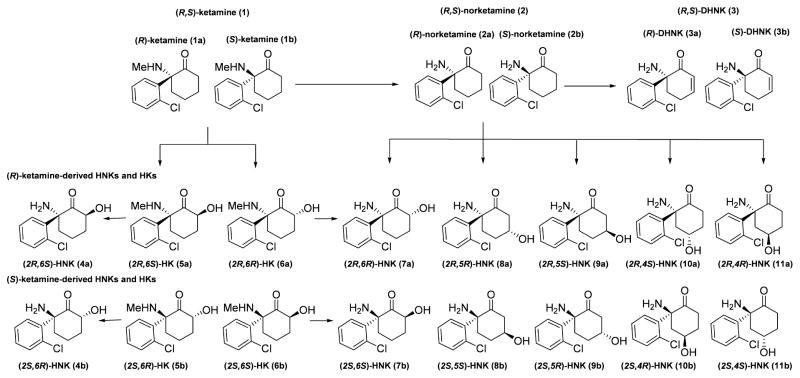Abstract
Ketamine is rapidly metabolized in the human body to a variety of metabolites, including the hydroxynorketamines. At least two hydroxynorketamines have significant antidepressant action in rodent models, with limited action against the N-methyl-D-aspartate (NMDA) receptor. The synthesis of 12 hydroxynorketamines and their binding affinity to the NMDA receptor is presented here.
Graphical Abstract
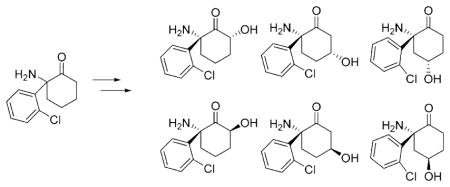
(R,S)-Ketamine (1) is an approved anesthetic and listed as an essential medicine by the World Health Organization (WHO).1 Ketamine has seen success in treating patients with refractory unipolar and bipolar depression.2 A recent meta-analysis of seven trials encompassing 147 ketamine-treated patients found that a single ketamine infusion produced rapid antidepressant effects, with odds ratios for response and transient remission of symptoms at 24 h equaling 9.87 and 14.47, respectively.3 To date, no other treatment for depression has demonstrated comparable outcomes in terms of the magnitude of response to a single dose for treatment-resistant depression. However, while ketamine has shown great promise for treating depression, its psychotomimetic and dissociative side effects as well as its abuse potential limit broad utility.
The mechanism by which ketamine generates such remarkable antidepressant effects is still under debate. Ketamine is a known N-methyl-D-aspartate (NMDA) receptor antagonist. However, multiple reports demonstrate that ketamine also modulates a wide range of cellular targets including muscarinic receptors, cholinergic receptors, nicotinic receptors, opioid receptors, and neuronal calcium and sodium channels.4 Furthermore, ketamine is utilized as the racemate, of which each enantiomer is rapidly metabolized in vivo to a combined mixture of at least 20 different metabolites (Figure 1).5,6
Figure 1.
Metabolism of ketamine.
The presence of several ketamine metabolites is observed in the circulating plasma of patients receiving subanesthetic doses of ketamine.6,7 Recently, Zanos and co-workers demonstrated that one of these metabolites, (2R,6R)-hydroxynorketamine ((2R,6R)-HNK, 7a), replicates ketamine’s antidepressant effects in mice without ketamine’s deleterious side effects.8 Only a limited number of these metabolites have been previously synthesized.6,7 Given the vast therapeutic potential of ketamine and/or its metabolites, we desired to construct expedient syntheses of the known hydroxynorketamine metabolites in order to assess their potential antidepressant activity.
Rapid access to the enantiopure hydroxynorketamines required an efficient and scalable synthesis to enantiopure norketamine. While several asymmetric syntheses of ketamine and norketamine have been published,9 a shorter route with fewer chromatographic separations was desired. Thus, a modification of the original synthetic route for ketamine, followed by a chiral resolution, was utilized.10 Starting from commercially available ketone 12, bromination of the cyclopentyl ketone, followed by condensation with concentrated ammonium hydroxide, gave imine 14.11 Use of microwave irradiation to accomplish the thermal rearrangement10 gave racemic norketamine (2) in 44% overall yield from commercial materials on gram scale without chromatographic purification. The published chiral resolution using tartaric acid had limitations on scale and required excessive solvent.11 A modified chiral resolution using pyroglutamic acid provided access to both enantiomers of norketamine on gram scale (Scheme 1).
Scheme 1.
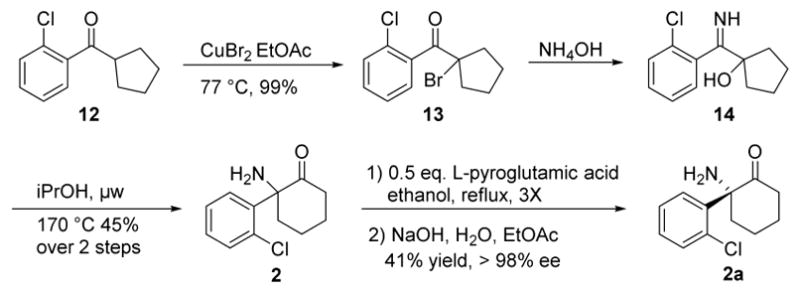
Synthesis of Enantiopure Norketamine (2a)
The synthesis of (2R, 6R)-hydroxynorketamine was based upon the racemic route originally reported by Leung and Baillie (Scheme 2).12 Replacement of the previously utilized methyl carbamate protecting group with a tert-butyl carbamate (BOC) proceeded in excellent yield. The following Rubottom oxidation gave a 72% yield and an excellent diastereomeric ratio to install the α-keto-alcohol with the desired stereochemistry. Lastly, deprotection of the BOC group with TFA gave the desired (2R,6R)-hydroxynorketamine (7a), which was then converted to the HCl salt.8 This allowed for multigram access to (2R,6R)-HNK, while its enantiomer was available via use of (S)-norketamine as a starting material.
Scheme 2.
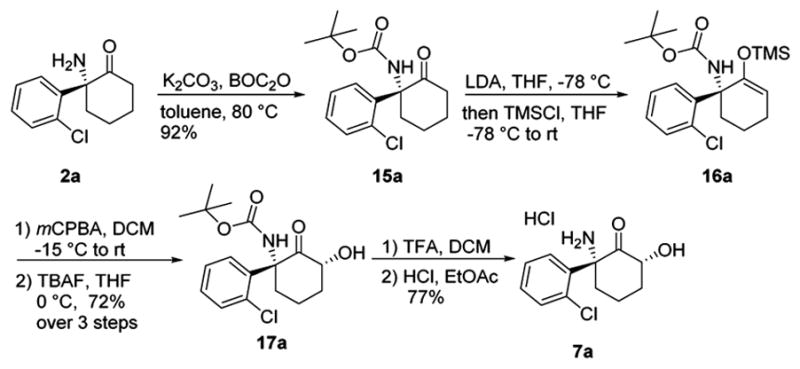
Synthesis of (2R,6R)-HNK (7a)
Ideally, (2R,6S)-hydroxynorketamine and its enantiomer would have also been accessed via the Rubottom oxidation. However, the stereoselectivity of the Rubottom oxidation provided the (Z)-stereochemistry near-exclusively under several conditions, so an alcohol-inversion strategy was instead utilized. Standard Mitsunobu conditions failed to invert the stereocenter due to the sensitive nature of the alcohol. Instead, treatment of 17a with triflic anhydride formed the triflate in near-quantitative yield, which was followed by SN2 displacement with 4-nitrobenzoate (Scheme 3) to give the benzoate ester 19a. Notably, use of acetate instead of nitrobenzoate led to a mixture of isomeric products. Cleavage of the nitrobenzoate ester with potassium carbonate in methanol followed by a careful TFA deprotection of the BOC group gave the desired (2R,6S)-hydroxynorketamine (4a) in 44% yield. Isolation of 4a required careful control of the pH and use of a pH 7 buffer, as even minimal contact with aqueous sodium bicarbonate (to generate the free base of the amine) led to product degradation.
Scheme 3.
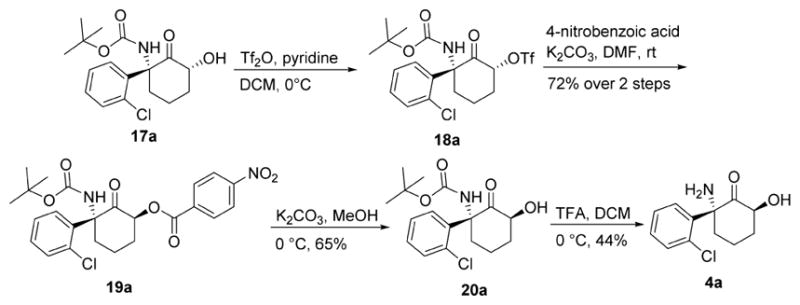
Synthesis of (2R,6S)-HNK (4a)
In order to synthesize the 5-hydroxynorketamines, an epoxidation–samarium diiodide epoxide opening route from dehydronorketaminne was utilized. Initially, (R)-dehydronorketamine (3a) was synthesized from (R)-norketamine (2a) by treatment with pyridium tribromide, followed by reaction with DBU (Scheme 4).13 Protection of the primary amine was followed by epoxidation with hydrogen peroxide in methanol to make 22a. Interestingly, only a single diastereomer was formed. Then, the epoxide was opened with samarium diiodide to give β-hydroxyketone 23a. Cleavage of the BOC group with trifluoroacetic acid afforded (2R,5R)-hydroxynorketamine (8a), and the relative stereochemistry was confirmed by X-ray crystallography.14
Scheme 4.
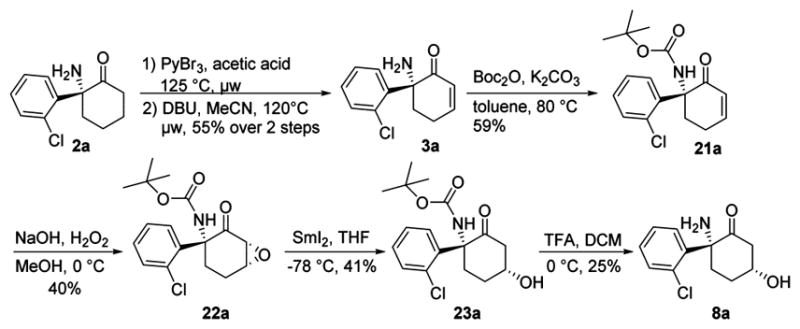
Synthesis of (2R,5R)-HNK (8a)
In order to access the other diastereomer for the 5-hydroxynorketamines, it was theorized that the steric bulk of the BOC group was forcing the aryl group to adopt a pseudoaxial conformation, and in the resulting conformation the aryl group would block epoxidation from the top face of the molecule. By starting with the unprotected amine, a low energy conformation which placed the aryl group equatorial might be accessed, allowing epoxidation from the top face. Impressively, once the BOC group was removed, under nearly identical epoxidation conditions, a mixture of the two diastereomers of the epoxynorketamine were obtained (Scheme 5) in a 3:1 ratio favoring diastereomer 24a (the addition to the top face of the molecule) with the epoxide pseudotrans to the amine. Samarium diiodide mediated opening of the epoxide gave the β-hydroxyketone in low yield after isolation. In this particular case, we hypothesize that without the more sterically bulky carbamate substituent, the cyclohexenone preferentially adopts a conformation which places the aryl group pseudoequatorial, thus allowing for nucleophilic attack of peroxide from the same face as the aryl group.
Scheme 5.
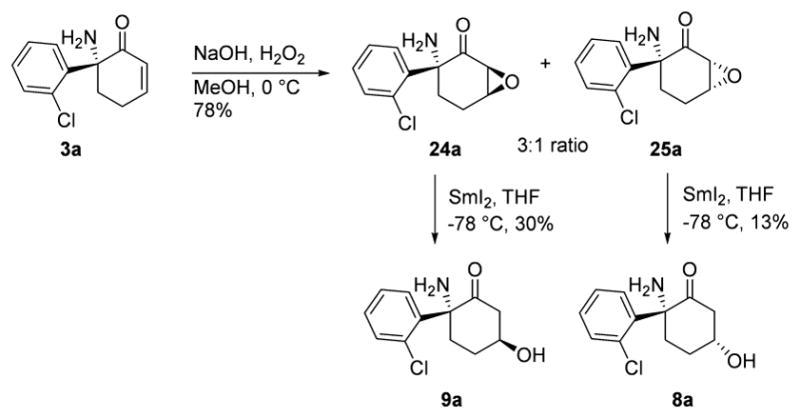
Synthesis of (2R,5S)-HNK (9a)
Synthetic access to the 4-hydroxynorketamines (Scheme 6) was planned via bromination of BOC-protected dehydronorketamine 21a, followed by displacement of the bromide with an oxygen nucleophile. However, bromination of 21a using NBS and AIBN led to a mixture consisting of allyl bromide 26a and cyclic carbonate 27a. This mixture could be further converted to 27a by treatment with sodium iodide in methanol. Reduction of 27a by hydrogenation, followed by basic hydrolysis of the carbonate, afforded (2R,4S)-HNK (10a) in 6% yield over four steps.
Scheme 6.
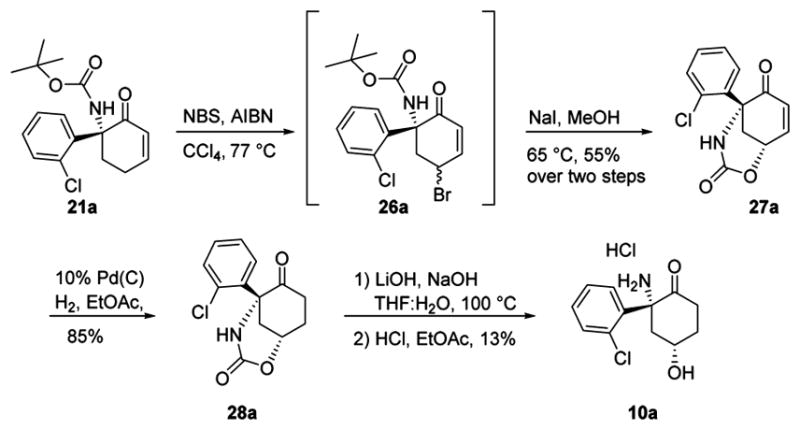
Synthesis of (2R,4S)-HNK (10a)
Unfortunately, the desired inversion of alcohol 10a to give (2R,4R)-hydroxynorketamine (11a) was unsuccessful under a variety of conditions. Thus, an alternative approach to synthesize the desired diastereomer was adopted. Starting from BOC-protected dehydronorketamine 21a, treatment with LDA and TMSCl formed the silyl enol diene 29a (Scheme 7).
Scheme 7.
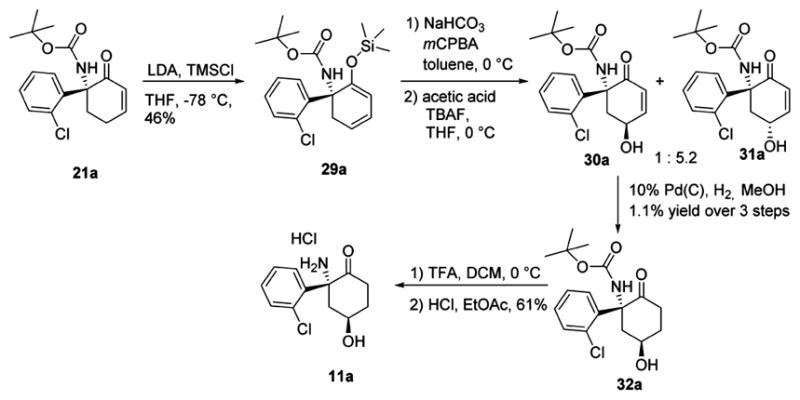
Synthesis of (2R,4R)-HNK (11a)
Then selective γ-δ epoxidation using mCPBA, followed by epoxide opening with a buffered TBAF system installed the desired hydroxyl group in the 4-position as a 1:5 mixture of diasteromers 30a and 31a, favoring undesired isomer 31a. In an analogy to both the synthesis of the 5-hydroxy- and 6-hydroxynorketamine systems, preferential epoxidation from the same side as the amide was seen. The resulting allyl alcohol 30a underwent immediate hydrogenation to deliver 32a. Finally, cleavage of the BOC group, followed by HCl salt formation, gave the desired (2R,4R)-hydroxynorketamine (11a). Following analogous routes, the enantiomers of all of these hydroxynorketamines were also synthesized. The absolute and relative stereochemistry for all hydroxynorketamines was unambiguously assigned by X-ray crystallography.14
One of the key aspects of this endeavor was to examine whether any of these newly synthesized ketamine metabolites have similar NMDA receptor activity to ketamine. Ketamine acts as a noncompetitive NMDA receptor antagonist, by binding to the MK-801 site of the NMDAR.15 It is broadly believed that this NMDA receptor antagonism is responsible for the anesthetic, analgesic, psychotomimetic, and dissociative effects that ketamine possesses and has also been postulated to be responsible for ketamine’s antidepressant effects.16 In order to assess the potential for the NMDA receptor activity of the synthesized metabolites, they were assayed against the MK-801 binding site of the NMDA receptor (Table 1).
Table 1.
Binding Affinities and Inhibitory Effects of Ketamine and Its Metabolites against the NMDA Receptor
| compd | IC50 (μM)a | Ki (μM)a | % inhibition at 100 μMa |
|---|---|---|---|
| (+)-MK-801 | 0.00493 | 0.00348 | 100 |
| (R,S)-ketamine (1) | 0.35 | 0.25 | 91 |
| (R)-norketamine (2a) | 0.85 | 0.6 | 90 |
| (S)-norketamine (2b) | 1.23 | 0.87 | 99 |
| (R)-DHNK (3a) | 59.7 | 42.1 | 68 |
| (S)-DHNK (3b) | 42 | 29.7 | 66 |
| (2R,6R)-HNK (7a) | >100 | >100 | 24 |
| (2S,6S)-HNK (7b) | 10.4 | 7.34 | 85 |
| (2R,6S)-HNK (4a) | >100 | >100 | 8 |
| (2S,6R)-HNK (4b) | >100 | >100 | 24 |
| (2R,5R)-HNK (8a) | >100 | >100 | 12 |
| (2S,5S)-HNK (8b) | >100 | >100 | 27 |
| (2R,5S)-HNK (9a) | >100 | >100 | 10 |
| (2S,5R)-HNK (9b) | >100 | >100 | 35 |
| (2R,4S)-HNK (10a) | >100 | >100 | 23 |
| (2S,4R)-HNK (10b) | >100 | >100 | 34 |
| (2R,4R)-HNK (11a) | >100 | >100 | 3 |
| (2S,4S)-HNK (11b) | >100 | >100 | 11 |
Measured via radioligand displacement of [3H]-MK801.
Results of the assay showed slightly stronger binding for both the control, (+)-MK-801, and ketamine itself than previous literature.17 As expected, ketamine has substantial activity against the NMDA receptor, as do its primary initial metabolites, (R)-and (S)-norketamine. The potential antidepressant (2R,6R)-HNK (7a) showed only 24% inhibition at 100 μM, consistent with a lack of NMDAR activity at clinically relevant concentrations.18 The (2S,6S)-HNK Ki of 7.32 μM is consistent with the previous finding that (2S,6S)-HNK exerts NMDAR inhibition-dependent side effects in mice at a dose of 25 mg/kg, while (2R,6R)-HNK does not exert these side effects at equivalent and higher doses.8
In conclusion, ketamine, a WHO essential medicine, and its metabolites, including the hydroxynorketamines, are quickly becoming leads for the next-generation treatment of depression. For the first time, every hydroxynorketamine is synthesized and the absolute and relative stereochemistry for these molecules are unambiguously assigned. Furthermore, the compounds were assessed for their activity against the MK-801 site of the NMDA receptor and 11 of the 12 hydroxynorketamines were shown to have no significant effect. This research lays the foundation for future investigations into the antidepressant properties of the previously unsynthesized hydroxynorketamines.
Supplementary Material
Acknowledgments
This work was supported by the NIH intramural research fund. Receptor binding profiles, IC50, and Ki determinations were performed by Eurofins Panlabs Discovery Services, Taipei, Taiwan.
Footnotes
Notes
The authors declare the following competing financial interest(s): R.M., and C.A.Z. are listed as co-inventors on a patent for the use of (2R,6R)-hydroxynorketamine, (S)-dehydronorketamine and other stereoisomeric dehydro and hydroxylated metabolites of (R,S)-ketamine metabolites in the treatment of depression and neuropathic pain. They have assigned their rights in the patent to the U.S. government but will share a percentage of any royalties that may be received by the government. C.A.Z., R.M., T.G., P.Z., C.T., and P.M. are listed as co-inventors on a patent application for the use of (2R,6R)-hydroxynorketamine and (2S,6S)-hydroxynorketamine in the treatment of depression, anxiety, anhedonia, suicidal ideation and post-traumatic stress disorders. C.A.Z., R.M., C.T., and P.M. have assigned their rights in this patent to the U.S. government but will share a percentage of any royalties that may be received by the government. T.G. and P.Z. have assigned their rights in this patent to the University of Maryland but will share a percentage of any royalties that may be received by the University of Maryland.
ASSOCIATED CONTENT
The Supporting Information is available free of charge on the ACS Publications website at DOI: 10.1021/acs.orglett.7b02177.
Experimental Procedures, characterization data, NMR spectra, and X-ray crystallographic data (PDF) X-ray data for all hydroxynorketamines (CIF, CIF, CIF, CIF, CIF, CIF, CIF, CIF, CIF, CIF, CIF, CIF)
References
- 1.Sinner B, Graf BM. Ketamine. Modern Anesthetics, Handbook of Experimental Pharmacology. 2008;182:313. doi: 10.1007/978-3-540-74806-9_15. [DOI] [PubMed] [Google Scholar]
- 2.(a) Zarate CA, Jr, Singh JB, Carlson PJ, Brutsche NE, Ameli R, Luckenbaugh DA, Charney DS, Manji HK. Arch Gen Psychiatry. 2006;63:856. doi: 10.1001/archpsyc.63.8.856. [DOI] [PubMed] [Google Scholar]; (b) Zarate CA, Jr, Brutsche NE, Ibrahim L, Franco-Chaves J, Diazgranados N, Cravchik A, Selter J, Marquardt CA, Liberty V, Luckenbaugh DA. Biol Psychiatry. 2012;71:939. doi: 10.1016/j.biopsych.2011.12.010. [DOI] [PMC free article] [PubMed] [Google Scholar]; (c) Coyle CM, Laws KR. Hum Psychopharmacol. 2015;30:152. doi: 10.1002/hup.2475. [DOI] [PubMed] [Google Scholar]
- 3.Newport DJ, Carpenter LL, McDonald WM, Potash JB, Tohen M, Nemeroff CB. Am J Psychiatry. 2015;172:950. doi: 10.1176/appi.ajp.2015.15040465. [DOI] [PubMed] [Google Scholar]
- 4.Sleigh J, Harvey M, Voss V, Denny C. Trends in Anaesthesia and Critical Care. 2014;4:76. [Google Scholar]
- 5.Zeilhofer HU, Swandulla D, Geisslinger G, Brune K. Eur J Pharmacol. 1992;213:155. doi: 10.1016/0014-2999(92)90248-3. [DOI] [PubMed] [Google Scholar]
- 6.Moaddel R, Venkata SLV, Tanga MJ, Bupp JE, Green CE, Iyer L, Furimsky A, Goldberg ME, Torjman MC, Wainer IW. Talanta. 2010;82:1892. doi: 10.1016/j.talanta.2010.08.005. [DOI] [PMC free article] [PubMed] [Google Scholar]
- 7.Zarate CA, Jr, Brutsche N, Laje G, Luckenbaugh DA, Venkata SL, Ramamoorthy A, Moaddel R, Wainer IW. Biol Psychiatry. 2012;72:331. doi: 10.1016/j.biopsych.2012.03.004. [DOI] [PMC free article] [PubMed] [Google Scholar]
- 8.Zanos P, Moaddel R, Morris PJ, Georgiou P, Fischell J, Elmer GI, Alkondon M, Yuan P, Pribut HJ, Singh NS, Dossou KSS, Fang Y, Huang XP, Mayo CL, Wainer IW, Albuquerque EX, Thompson SM, Thomas CJ, Zarate CA, Jr, Gould TD. Nature. 2016;533:481. doi: 10.1038/nature17998. [DOI] [PMC free article] [PubMed] [Google Scholar]
- 9.(a) Yang X, Toste DF. J Am Chem Soc. 2015;137:3205. doi: 10.1021/jacs.5b00229. [DOI] [PMC free article] [PubMed] [Google Scholar]; (b) Biermann M, Zheng G, Hojahmat M, Moskalev NV, Crooks PA. Tetrahedron Lett. 2015;56:2608. [Google Scholar]
- 10.Stevens CL, Thuillier A, Taylor KG, Daniher FA, Dickerson JP, Hanson HT, Nielsen NA, Tikotkar NA, Weier RM. J Org Chem. 1966;31:2601. [Google Scholar]
- 11.Hong SC, Davisson JN. J Pharm Sci. 1982;71:912. doi: 10.1002/jps.2600710818. [DOI] [PubMed] [Google Scholar]
- 12.Leung LY, Baillie TA. J Med Chem. 1986;29:2396. doi: 10.1021/jm00161a043. [DOI] [PubMed] [Google Scholar]
- 13.Parcell RF, Sanchez JP. J Org Chem. 1981;46:5055. [Google Scholar]
- 14.See Supporting Information.
- 15.(a) Ferrer-Montiel AV, Sun W, Montal M. Proc Natl Acad Sci U S A. 1995;92:8021. doi: 10.1073/pnas.92.17.8021. [DOI] [PMC free article] [PubMed] [Google Scholar]; (b) Berman FW, Murray TF. J Biochem Toxicol. 1996;11:217. doi: 10.1002/(SICI)1522-7146(1996)11:5<217::AID-JBT2>3.0.CO;2-N. [DOI] [PubMed] [Google Scholar]
- 16.Dale E, Bang-Andersen B, Sanchez C. Biochem Pharmacol. 2015;95:81. doi: 10.1016/j.bcp.2015.03.011. [DOI] [PubMed] [Google Scholar]
- 17.Moaddel R, Abdrakhmanova G, Kozak J, Jozwiak K, Toll L, Jimenez L, Rosenberg A, Tran T, Xiao Y, Zarate CA, Wainer IW. Eur J Pharmacol. 2013;698:228. doi: 10.1016/j.ejphar.2012.11.023. [DOI] [PMC free article] [PubMed] [Google Scholar]
- 18.(a) Suzuki K, Nosyreva E, Hunt KW, Kavalali ET, Monteggia LM. Nature. 2017;546:E1. doi: 10.1038/nature22084. [DOI] [PubMed] [Google Scholar]; (b) Zanos P, Moaddel R, Morris PJ, Georgiou P, Fischell J, Elmer GI, Alkondon M, Yuan P, Pribut HJ, Singh NS, Dossou KSS, Fang Y, Huang XP, Mayo CL, Albuquerque EX, Thompson SM, Thomas CJ, Zarate CA, Jr, Gould TD. Nature. 2017;546:E4. doi: 10.1038/nature22085. [DOI] [PMC free article] [PubMed] [Google Scholar]
Associated Data
This section collects any data citations, data availability statements, or supplementary materials included in this article.



